I have been, or can be if you click on a link and make a purchase, compensated via a cash payment, gift, or something else of value for writing this post. As an Amazon Associate, I earn from qualifying purchases. Please read my full Affiliate Disclosure for more information.
Have you ever been captivated by the serene beauty of Wabi-Sabi, the Japanese philosophy that finds perfection in imperfection and transience? This aesthetic has gained immense popularity for its calming, authentic appeal that promotes mindfulness and simplicity in everyday life.
In this article, you’ll explore a variety of Wabi-Sabi interior ideas that celebrate natural textures, imperfect forms, and understated elegance. Whether you’re looking to create a cozy nook or a tranquil living space, these ideas will inspire you to embrace the beauty of imperfection and bring a soothing, organic vibe into your home.
1. Embrace Imperfect Wooden Furniture with Weathered Finishes
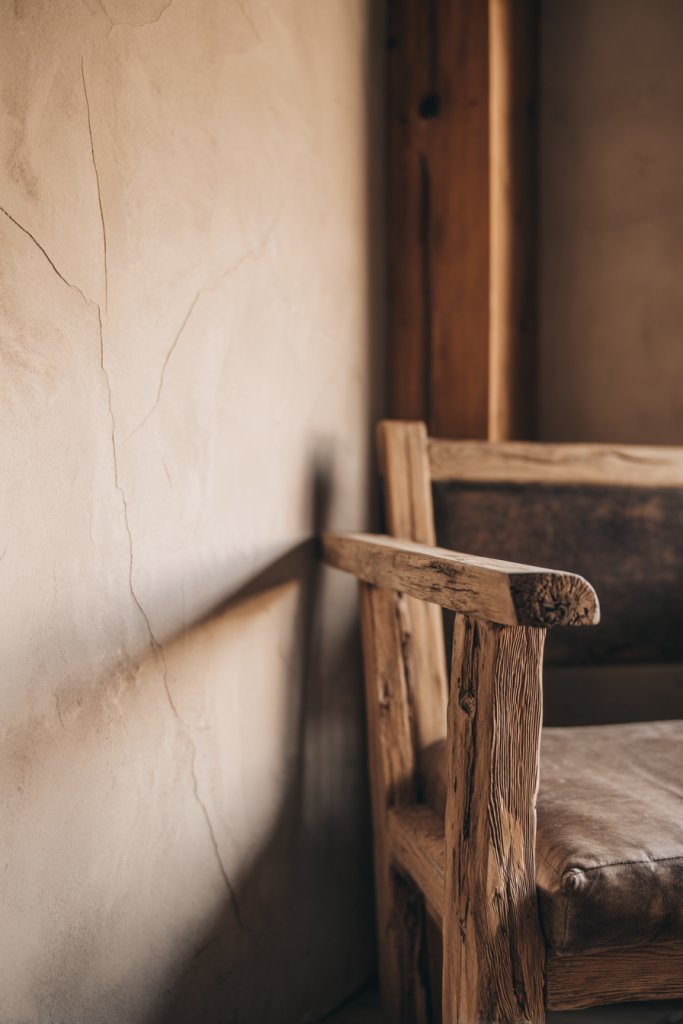
Ever feel overwhelmed by perfectly polished furniture that feels cold and impersonal? Wabi-sabi celebrates the beauty of flaws and imperfections, making your space feel more authentic and welcoming. It’s about embracing the character that age and use bring to furniture, rather than hiding it behind glossy finishes. If your goal is a space that feels lived-in and genuine, this idea is a game-changer.
Imagine a vintage wooden table with visible grain, knots, and subtle dents that tell a story. Picture a set of chairs with chipped paint and uneven surfaces, giving them unique personality. Weathered finishes lend warmth and texture, creating a cozy, rustic atmosphere. The natural imperfections catch the light differently, adding depth and visual interest to the room. These pieces exude history and authenticity.
You can choose lighter woods for a Scandinavian vibe or darker, richer tones for a more traditional look. Incorporate reclaimed furniture for an eco-friendly approach, or mix and match different textures for an eclectic feel. Weathered finishes work well in both modern minimalist spaces and more rustic, farmhouse styles. Seasonal accents like cozy throws or candles can further enhance the aged charm.
Start by sourcing furniture with natural flaws or intentionally distress new pieces for a weathered look. Use sandpaper or wire brushes to gently age wood surfaces, revealing underlying grain. Finish with natural oils or matte varnishes to enhance the aged appearance without gloss. Focus on pieces that have visible grain, knots, and irregularities—these are your aesthetic anchors. Mix different textures and heights for visual balance. Regular maintenance involves simple cleaning and occasional touch-ups to preserve character.
Add personal touches like hand-carved details or unique hardware to make each piece truly yours. Incorporate textiles like linen cushions or woven throws that complement the rustic wood. Consider painting some surfaces with muted, earthy tones to create contrast while preserving the weathered look. You can also display vintage finds nearby to reinforce the authentic vibe. Personalization turns these furniture pieces into storytelling elements in your home.
Embracing weathered wood proves that beauty isn’t about perfection but about history and character. Your space will radiate warmth and authenticity, inviting relaxation and conversation. Don’t be afraid to experiment—each imperfection adds value and uniqueness. Ready to give your home that lived-in, soulful feel that everyone secretly admires?
2. Incorporate Raw Textured Linen Textiles for Cozy Comfort
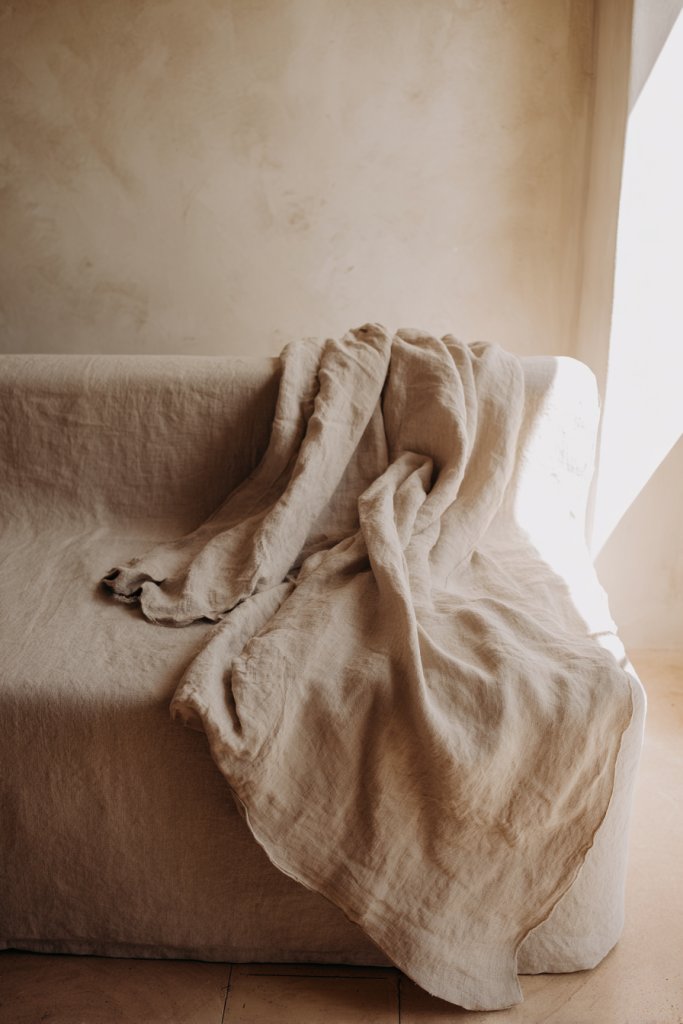
Tired of stiff, synthetic fabrics that feel cold and uninviting? Linen textiles bring a natural, relaxed vibe that instantly adds comfort and a touch of rustic charm. They’re perfect for creating that effortless, lived-in look that makes a space feel welcoming. If you crave a cozy yet elegant environment, linen is your new best friend.
Imagine flowing linen curtains with subtle wrinkles that catch the light softly, creating gentle shadows. Think of a chunky knit throw in a muted tone draped casually over a sofa, inviting touch. Linen cushions with a slightly crinkled surface add depth and texture, contrasting beautifully with smoother surfaces. These textiles have a tactile quality that makes you want to sink in and relax.
Unbleached, natural linen works well in neutral color palettes, but you can also experiment with muted dyes for subtle pops of color. Layering different textures—like a rougher burlap or soft cotton—can add visual interest. During colder months, thicker linen throws provide warmth, while lighter curtains keep the space airy in summer. You can also incorporate linen slipcovers for furniture for a quick style update.
Choose high-quality linen fabrics, opting for natural or undyed options for authenticity. Sew simple pillow covers, throws, or curtains, or buy ready-made. Wash linens before use to enhance their natural wrinkled look and soft texture. Use natural dyes or leave them in their raw state for a more organic appearance. Mix and match different linen textures and weights for layered depth. Regular washing and gentle care keep the textiles looking their best.
Personalize with embroidered details or subtle piping for a bespoke touch. Pair linen textiles with wooden or woven furniture for a harmonious natural palette. Experiment with contrasting stitching or fringe details for a handcrafted feel. Layering different textiles—like a linen cushion on a wool blanket—can make your space feel more inviting. These small touches turn simple textiles into statement elements.
Linen’s natural appeal encourages a relaxed, comfortable lifestyle. It’s an easy way to elevate your home without fuss or fussiness. Embrace the imperfections and enjoy the tactile richness—your space will feel authentic and cozy. Ready to wrap yourself in softness and natural beauty?
3. Use Earth-Toned Paints with Subtle Variations for Wall Color

Looking to create a calming, grounded atmosphere without overwhelming your senses? Earth-toned paints provide a subtle, natural backdrop that instantly soothes. They evoke a sense of stability and connection to nature, perfect for those seeking serenity in their home. If bland white walls bore you, these gentle hues might be your new go-to.
Imagine walls painted in warm taupe or soft clay, with gentle color shifts that mimic natural mineral deposits. The subtle variations in tone add depth and dimension, making the space feel more organic. Light plays differently on these surfaces, creating a soft glow that enhances textures and architectural details. These colors foster a peaceful, timeless aesthetic.
Combine different earth tones in a monochromatic palette for a layered, sophisticated look. Use matte or eggshell finishes to enhance the organic feel, avoiding glossy surfaces. In small spaces, lighter shades expand the room visually, while darker tones add intimacy and coziness in larger rooms. Seasonal accents like natural fiber rugs or woven baskets complement these hues beautifully.
Select high-quality, low-VOC paints in earthy shades. Test color samples on different walls to observe how they change with lighting throughout the day. Use brushes and rollers suited for matte finishes, and apply multiple thin coats for even coverage. Incorporate subtle gradients or wash techniques for added texture. Keep the palette simple—avoid overly bright or saturated colors—to preserve the understated charm.
Add dimension with textured wall treatments like lime wash or subtle plaster effects. Use natural materials such as wood or stone to reinforce the earthy theme. Incorporate layered textiles with muted tones to deepen the visual richness. Personalize by creating accent walls or sections with slightly varied shades for a handcrafted look. These small tweaks make your walls a canvas of natural beauty.
Earth-inspired walls foster tranquility and a deeper sense of home. They serve as a versatile backdrop for almost any decor style, from minimalist to bohemian. These colors age gracefully and require minimal maintenance, making them practical too. Embrace the subtle variations that mimic nature’s own palette for a truly authentic vibe.
4. Display Handmade Ceramic Vessels with Organic Shapes
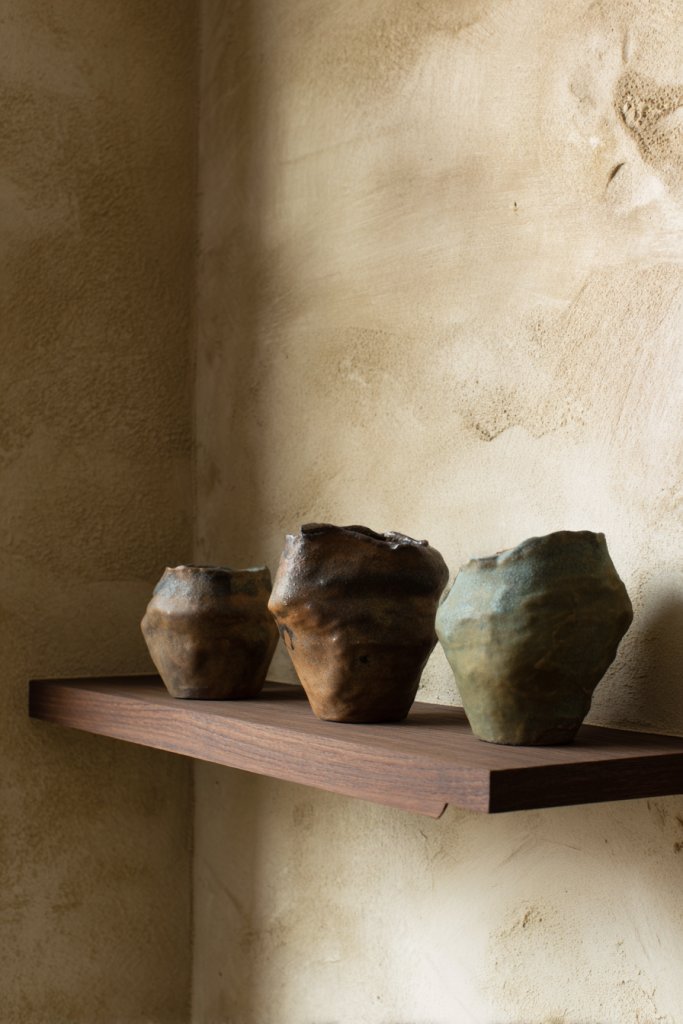
Ever feel like your decor lacks a certain handcrafted charm? Handmade ceramic vessels with organic shapes inject personality and tactile interest into any space. They celebrate imperfection and artistry, elevating your decor from mundane to meaningful. If you love the idea of unique, one-of-a-kind pieces, this is your chance.
Picture a collection of irregularly shaped bowls and pitchers with textured surfaces and uneven rims. The glazes often have subtle variations, highlighting the artisan’s touch. These vessels look beautiful when grouped on open shelving or placed on rustic wooden trays. Their tactile quality invites curiosity and invites you to touch and explore. The imperfections make each piece feel alive.
Arrange a mix of sizes and shapes for visual rhythm, or keep it simple with a few statement pieces. Use them as functional containers for everyday essentials or as decorative accents. Pair with natural fabrics and wooden elements for a cohesive organic look. During different seasons, swap out contents or add seasonal elements like dried botanicals or stones—no vases needed!.
Source pottery from local artisans or craft fairs, or try making your own for a truly personal touch. Focus on irregular shapes, textured glazes, and natural clay tones. When displaying, keep the arrangement loose and asymmetrical for maximum wabi-sabi effect. Clean with gentle soap and avoid harsh scrubbing to preserve the textured surfaces. Use open shelving or place on handcrafted trays for maximum visual impact.
Customize with engraved initials, patterns, or subtle color accents. Use these vessels for everyday storage or as standalone decor items. Incorporate natural elements like stones or driftwood inside for added character. Pair with other artisanal crafts like woven baskets or textured textiles to create a layered, curated aesthetic. Personal touches turn these vessels into meaningful art.
Handmade ceramics embody the spirit of wabi-sabi—imperfect, authentic, and beautiful. They remind us that beauty exists in the irregular and the aged. Your space will radiate warmth and individuality, making visitors feel at home. Dive into artisanal crafts and enjoy the process of collecting or creating your own unique pieces.
5. Integrate Open Shelving with Worn-Look Clutter-Free Arrangements
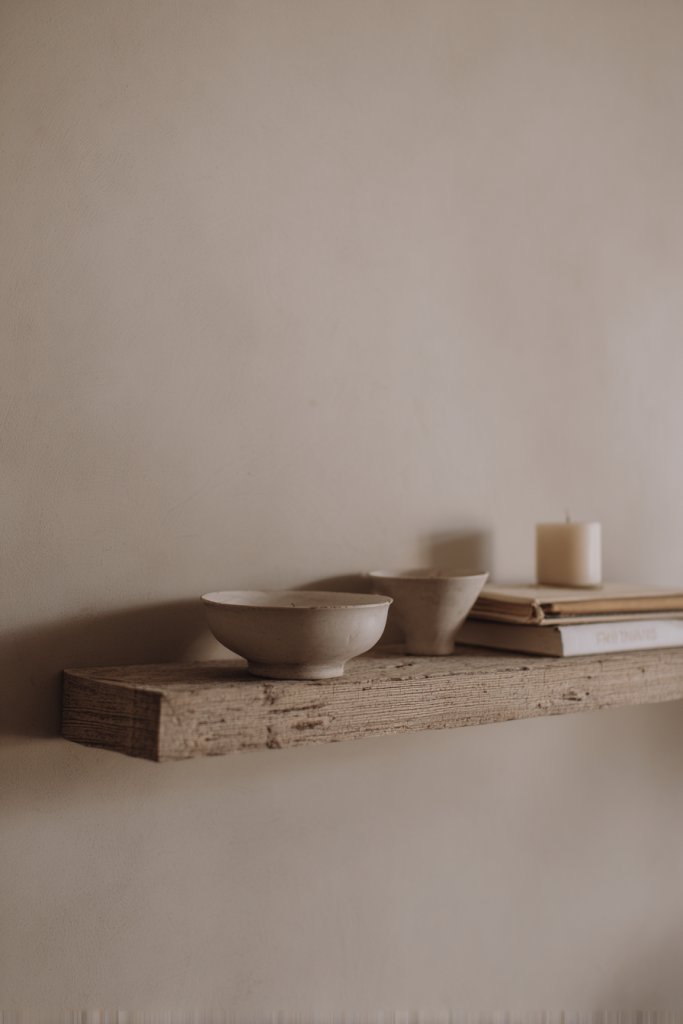
Does your cluttered cluttered shelves make your space feel chaotic instead of cozy? Open shelving with a curated, worn look can transform chaos into calm. It emphasizes simplicity and allows your home’s character to shine through. If you want an organized yet relaxed vibe, this style is a perfect fit.
Imagine rustic wooden shelves with chipped paint and uneven edges, mounted on textured walls. Carefully arranged objects—like vintage jars, textured ceramics, or woven baskets—create a balanced, clutter-free display. The worn look adds depth and history, making your shelves feel like a curated antique market. The open design invites the eye to explore and discover.
Use open shelving in kitchens, living rooms, or bathrooms, pairing it with different textures and materials. Keep clutter minimal to maintain a peaceful aesthetic—think a few carefully chosen items per shelf. For seasonal updates, swap objects or add textiles like linen towels or wool blankets nearby. You can also layer items with varying heights and textures for visual richness.
Start with sturdy, aged wood or reclaimed materials for the shelves. Mount them securely to support your chosen objects, ensuring they’re level but not overly perfect. Keep the display simple—avoid overcrowding—and focus on balance. Regular dusting and gentle cleaning keep the worn look authentic. Use hooks or small brackets to add subtle architectural interest.
Add personal touches like vintage tools, handmade ceramics, or meaningful collectibles. Incorporate textiles like woven baskets or linen cloths to soften the look. Create asymmetry deliberately to reinforce the imperfect beauty of wabi-sabi. Play with color accents in the objects or wall behind for contrast. These curated arrangements reflect your personality.
Open shelving with a worn look proves that less is more. It encourages mindful selection of decor and celebrates the aged, imperfect charm. Your space will feel curated and authentic, inviting lingering admiration. Embrace the rustic imperfections and enjoy a space that tells your story beautifully.
6. Incorporate Large, Unmilled Stones as Decorative Accents

Ever want to add a touch of earthiness and raw beauty to your decor? Large, unmilled stones bring a natural, grounding element that’s hard to replicate artificially. They evoke the rugged landscapes and primal textures we find captivating. If you crave a connection to nature within your home, this idea is for you.
Picture a collection of rough, unpolished stones arranged on a wooden tray or nestled in a simple bowl. Their irregular shapes and textures create visual interest and tactile appeal. Placed on a mantle or a side table, they serve as a subtle reminder of the outdoors. The natural variations in color and form make each stone a unique piece of art.
Use different sizes and shapes for visual rhythm, or focus on a single, large stone as a statement piece. Integrate them into a Zen-inspired space or rustic vignette. Combine with driftwood, sand, or natural fibers for a layered, organic look. Seasonal themes could involve adding moss or small plants, but avoid over-embellishing to keep the raw feel.
Source stones directly from nature, local beaches, or stone suppliers. Clean gently with water to remove dirt, avoiding harsh chemicals. Place them on trays, in bowls, or on pedestals for display. Keep arrangements simple and natural, avoiding symmetry or overly curated layouts. Regularly dust or rinse as needed to maintain their rugged appearance.
Create themed arrangements, such as a collection of smooth river stones paired with textured ceramics. Use stones as paperweights or decorative accents on shelves or tables. Add small elements like sand or pebbles for contrast. Incorporate storytelling by collecting stones from memorable places or trips—these become personal artifacts.
Unmilled stones demonstrate that beauty is often found in the raw and unrefined. They reinforce a natural, grounded lifestyle and add an element of surprise. Your space will feel more connected to the outdoors and evoke a sense of calm. No matter the setting, these stones serve as timeless, earthy accents.
7. Use Unfinished or Reclaimed Wood Beams as Structural or Decorative Elements
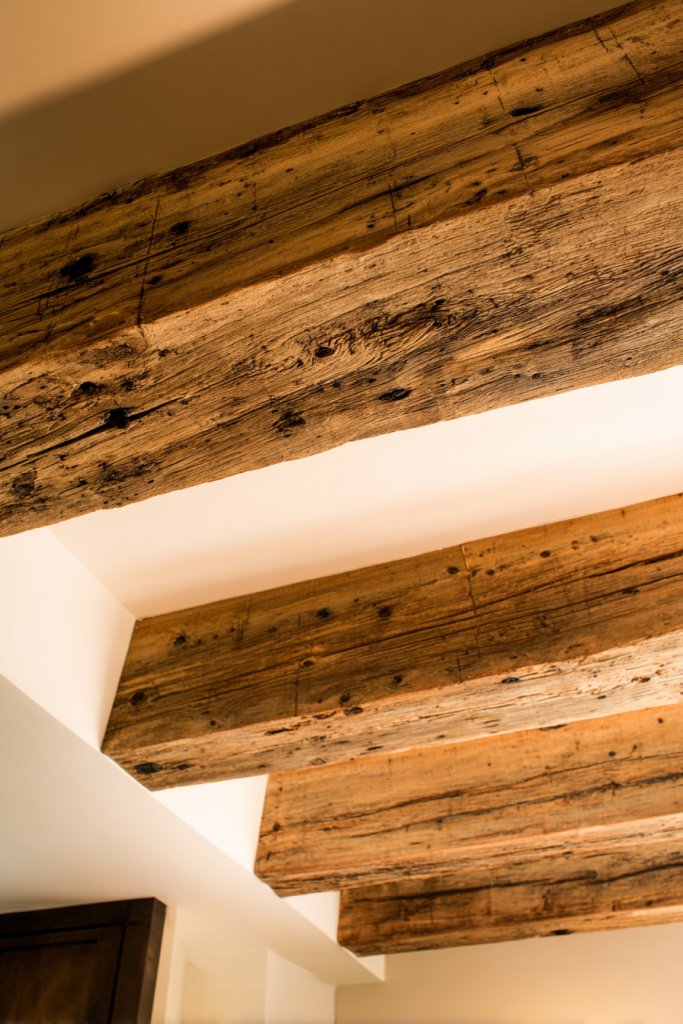
Want to add character and a touch of history to your space without a full renovation? Unfinished or reclaimed wood beams offer instant rustic charm. They create visual interest while celebrating sustainable, eco-friendly design. If you love the idea of a space that feels rooted in tradition, this is your move.
Imagine exposed beams with rough-hewn textures and natural cracks, framing your ceiling or dividing spaces. These beams add a sense of permanence and history, as if your home has stories to tell. Their weathered surfaces catch the light differently, emphasizing their natural imperfections. They can be a focal point or a subtle architectural detail.
Use reclaimed wood in open-plan living areas or as accent features in bedrooms or kitchens. Pair with other rustic materials like stone or brick for a layered look. The beams can be left raw or lightly treated for a specific aesthetic—rough and rugged or slightly polished. Seasonal decor can include textiles or lighting that emphasizes their natural beauty.
Source reclaimed or unfinished timber from local mills or salvage yards. Have professional carpenters install beams securely, ensuring safety and stability. Keep the natural textures intact, avoiding heavy finishes. Maintain their weathered look with periodic cleaning and minimal treatment. Use them as structural elements or as decorative ceiling features.
Decorate beams with subtle string lighting or hang handcrafted ornaments from them. Use complementary furniture with aged finishes to reinforce the rustic vibe. Incorporate vintage or handcrafted fixtures nearby for continuity. Personalize with carvings, initials, or painted accents to make each beam unique.
Using reclaimed or unfinished wood beams celebrates history and craftsmanship. They add warmth and authenticity that can’t be duplicated with faux materials. Your home gains an immediate sense of character and timeless appeal. Embrace the imperfect beauty of natural wood—it’s a statement of eco-conscious style.
8. Create a Calm, Neutral Color Palette with Subtle Variations
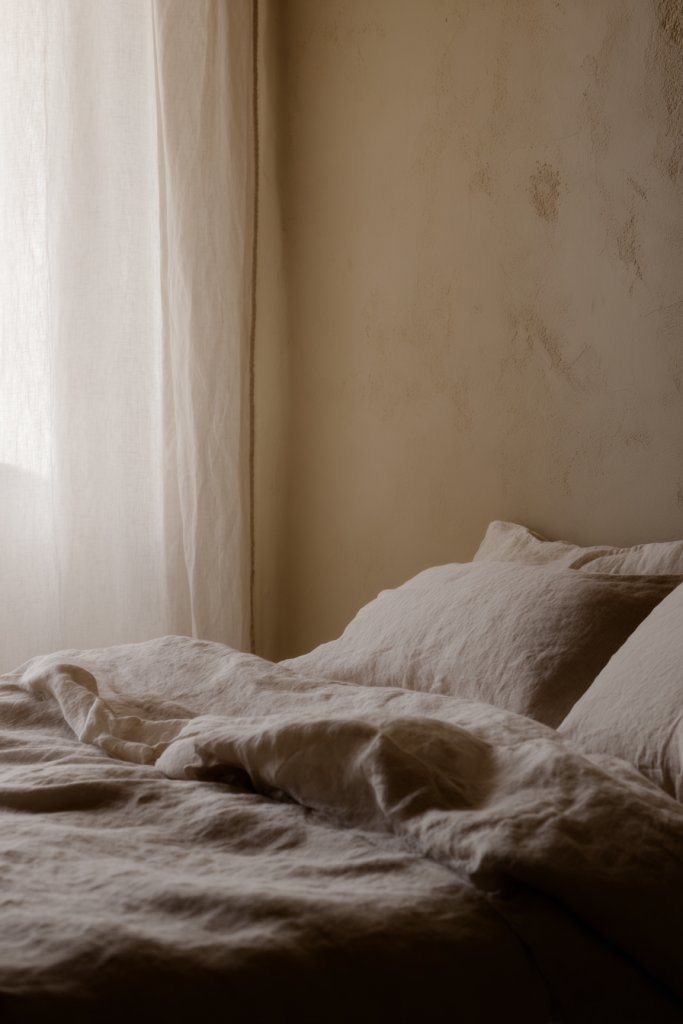
Ever feel overwhelmed by loud, busy walls that zap your peace of mind? A calm, neutral color palette offers a quiet retreat within your home. It’s perfect for anyone craving serenity and understated elegance without the chaos of bright hues. But achieving that perfect balance of subtlety can seem tricky—until you understand the magic of gentle variations.
Imagine walls painted in warm taupe, with soft gradients that shift gently from light to slightly darker shades. The textured linen curtains in muted beige complement the muted earth tones, creating a layered, harmonious look. Natural light dances across the surface, emphasizing the subtle differences in tone. The overall effect feels soothing, like a soft whisper of color that calms the mind.
You can adapt this palette by introducing cooler grays for a more modern vibe or warm creams for coziness. Seasonal changes could involve swapping out textiles—think cozy wool throws in winter or lightweight linen in summer. Smaller rooms benefit from lighter shades to open up space, while larger areas can handle deeper, richer neutrals. The key is to keep variations minimal but intentional.
Start by selecting a base neutral shade—preferably a mid-tone taupe or warm gray. Use high-quality, low-VOC paints that allow for smooth, even coverage. Apply with a roller or brush, blending subtle gradients if desired. Incorporate textured fabrics and matte finishes to enhance depth. Keep the lighting soft and natural to showcase the nuanced color shifts. Test patches before committing for the best result.
Add personal touches with layered textiles in different textures—think a soft cream throw blanket or a chunky knit cushion in similar tones. Incorporate natural materials like unfinished wood or stone to complement the calm palette. Small art pieces or handcrafted ceramics in similar hues can subtly add interest without disrupting the serenity. The goal is to create a cohesive, restful environment.
A neutral palette with subtle variations is timeless and adaptable, allowing your space to evolve with minimal effort. It’s a versatile foundation that works well with any style, from rustic to modern. With a little patience and the right shades, you can craft a peaceful sanctuary that feels both luxurious and effortless. Ready to embrace the quiet beauty of understated color?
9. Incorporate Worn Leather or Linen Upholstery for Textural Contrast
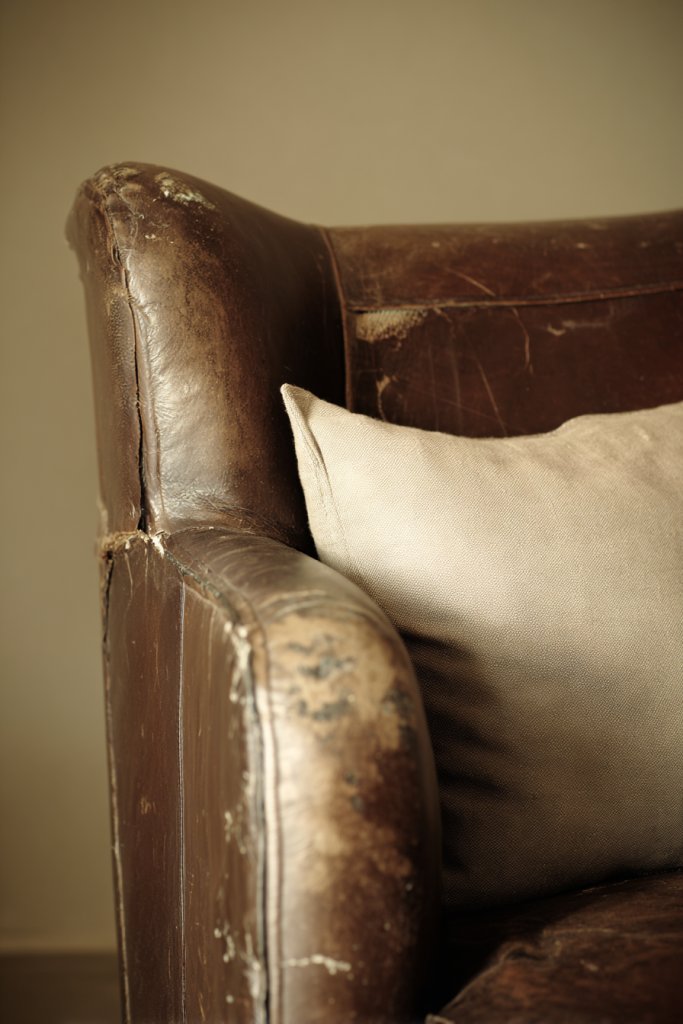
Tired of furniture that looks pristine but feels cold and impersonal? Worn leather and linen upholstery bring authenticity and warmth to any space. They add a layer of tactile richness that instantly makes a room feel lived-in and cozy. Plus, they age beautifully—getting better with time, unlike synthetic fabrics that fade or peel.
Picture a vintage leather armchair with a slightly distressed finish, paired with a soft, wrinkled linen sofa in neutral tones. The textures invite you to touch and settle in, creating an inviting contrast to sleek, polished surfaces. The natural imperfections tell a story of history and character, making the furniture feel unique. The aged leather emits a subtle patina, while the linen’s gentle wrinkles add depth and softness.
Choose leather that develops a rich, cracked patina over time or opt for a smoother, softer finish if you prefer a sleeker look. Linen fabrics can vary from crisp and structured to loose and relaxed—pick what suits your style. These materials work well in both rustic and contemporary settings, depending on how you accessorize. Layering different textures is a simple way to personalize.
Look for furniture with genuine leather or linen upholstery from reputable sources. If reupholstering, choose durable, natural textiles that age well. Maintain leather by conditioning it periodically with natural oils, avoiding harsh chemicals. Linen requires gentle washing and air drying, but it’s remarkably low-maintenance overall. Incorporate these pieces into your existing furniture arrangement, mixing and matching for a curated, eclectic feel.
You can personalize these materials further by adding decorative stitching details or contrasting piping. Use vintage or handcrafted leather pieces for a truly unique look. Add plush cushions or throws in complementary fabrics to soften the look or to create a layered, cozy aesthetic. This combination invites relaxation and storytelling within your space.
Using worn leather and linen not only adds character but also reduces the pressure for perfection. It’s a low-fuss way to introduce natural textures that improve with age. Your space will feel authentic, warm, and inviting—perfect for unwinding after a long day. Embrace the beauty of imperfection and let your furniture tell a story.
10. Add Handwoven Baskets and Natural Fiber Storage Solutions
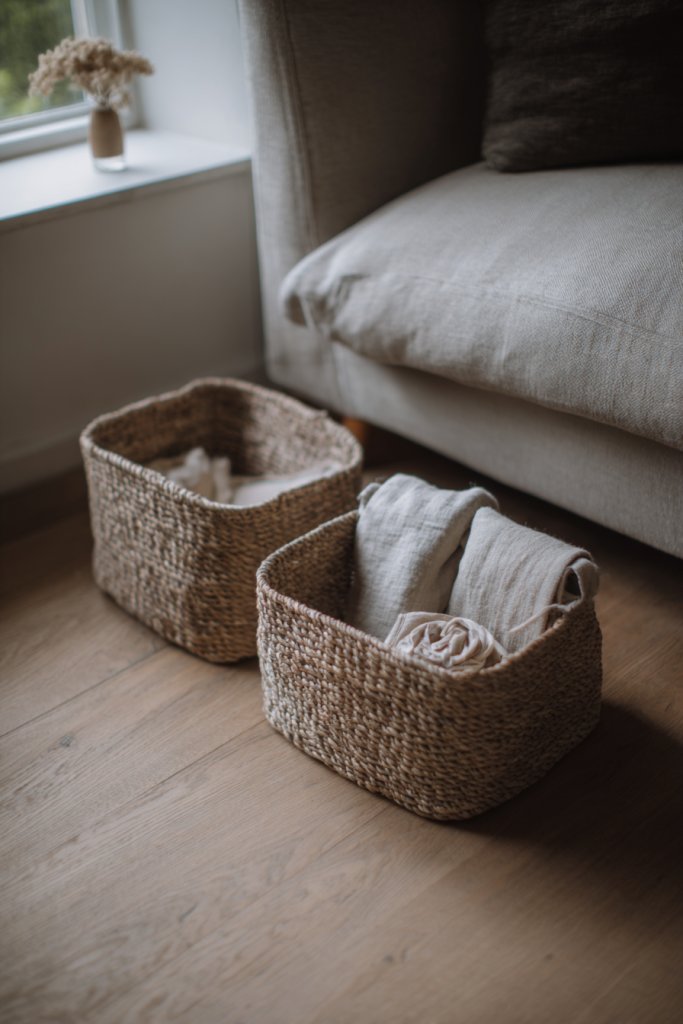
Clutter can turn even the most beautiful space into chaos fast. Finding stylish storage that doesn’t compromise your aesthetic is a constant challenge. Handwoven baskets and natural fiber containers solve this dilemma by blending function with organic beauty. They’re a practical yet charming solution for keeping essentials tidy.
Visualize a set of jute baskets stacked neatly beside a sofa or under a console table. Their rough textures and earthy tones add warmth and a touch of the outdoors to your room. The woven patterns create subtle visual interest, while the natural fibers provide a tactile contrast against smooth surfaces. They’re perfect for storing throws, magazines, or small essentials, keeping your space looking effortlessly organized.
Choose baskets in different sizes and shapes to suit various storage needs. For a more refined look, select baskets with tight weaves or decorative accents like leather handles. These solutions work well in open shelving, under beds, or in entryways. Seasonal swaps—like lighter jute for summer or darker seagrass for winter—add versatility.
Select baskets made from durable, eco-friendly fibers like rattan, seagrass, or jute. Place them strategically in your living or storage areas for easy access. For added style, incorporate lids or decorative fringes, but prioritize practicality. Regularly clean with a gentle brush or vacuum to maintain their texture and appearance. These baskets are easy to move and reconfigure as your needs evolve.
Personalize baskets by adding fabric linings or painted patterns on their exteriors. Pair them with matching woven trays or small containers for a cohesive look. Use them to create visual zones within a room—group similar items together for a tidy, curated feel. They can also double as decorative accents when left empty.
Natural fiber baskets elevate your organization game while maintaining a relaxed, organic vibe. They help you embrace a clutter-free lifestyle without sacrificing style. With a little effort, you’ll turn simple storage into a design feature that adds character and warmth. Your space will feel more inviting and effortlessly put together.
11. Install Minimalist, Unpolished Light Fixtures with Warm Glow
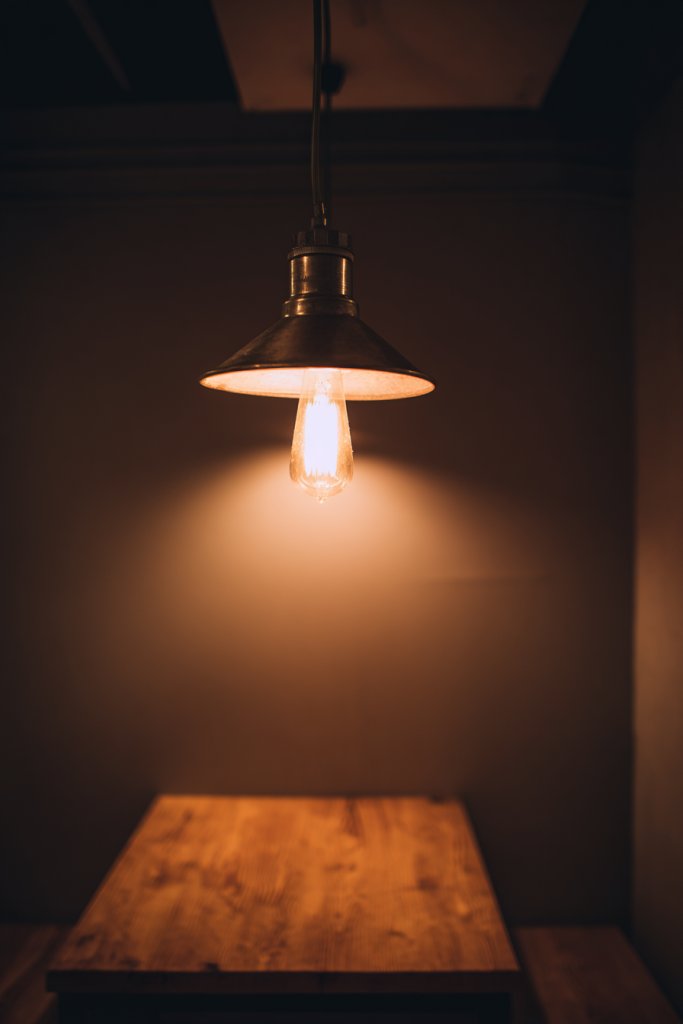
Bright, overly polished lighting can make a space feel sterile and uninviting. A warm, unpolished light fixture creates a cozy atmosphere that beckons relaxation. It’s about embracing simplicity and authenticity in every detail, even in lighting choices. But finding fixtures that offer both minimalism and warmth can seem daunting—until you explore unpolished, matte finishes.
Picture a matte black or brushed brass pendant with an exposed filament bulb hanging over a dining table or reading nook. The soft glow filters through the unpolished surface, casting gentle shadows that enhance the room’s textures. Its raw finish complements natural materials like wood and linen, emphasizing a handcrafted, organic aesthetic. The warm light adds a subtle glow that makes the space feel welcoming, not clinical.
Choose fixtures with matte, brushed, or raw metal finishes for a rustic or industrial vibe. For softer aesthetics, opt for fixtures with textured or distressed surfaces. You can incorporate wall sconces or simple ceiling mounts with exposed bulbs for a minimalist look. These fixtures adapt well to various styles, from modern farmhouse to modern minimalist.
Select fixtures made from durable, natural-looking materials that develop character over time. Install in areas where ambient light is needed—living rooms, bedrooms, or hallways. Use dimmer switches to control the warmth and intensity of the glow. Pair with energy-efficient filament bulbs to enhance the vintage feel. Keep wiring minimal and clean to preserve the unpolished aesthetic.
Customize by choosing fixtures with different textures or finishes—like hammered metal or matte ceramic. Add decorative filament or Edison bulbs for extra character. Incorporate dimming features to adjust mood lighting easily. Mix and match fixtures in different rooms for a cohesive yet eclectic look that emphasizes simplicity.
Unpolished, warm glow fixtures bring a sense of handcrafted authenticity to your home. They promote a relaxed atmosphere perfect for unwinding. With the right selection, your lighting becomes a subtle yet powerful design element that enhances your entire space. Embrace the beauty of imperfect finishes and make your lighting work for you.
12. Arrange Asymmetrical, Organic-Shape Mirrors for Visual Interest
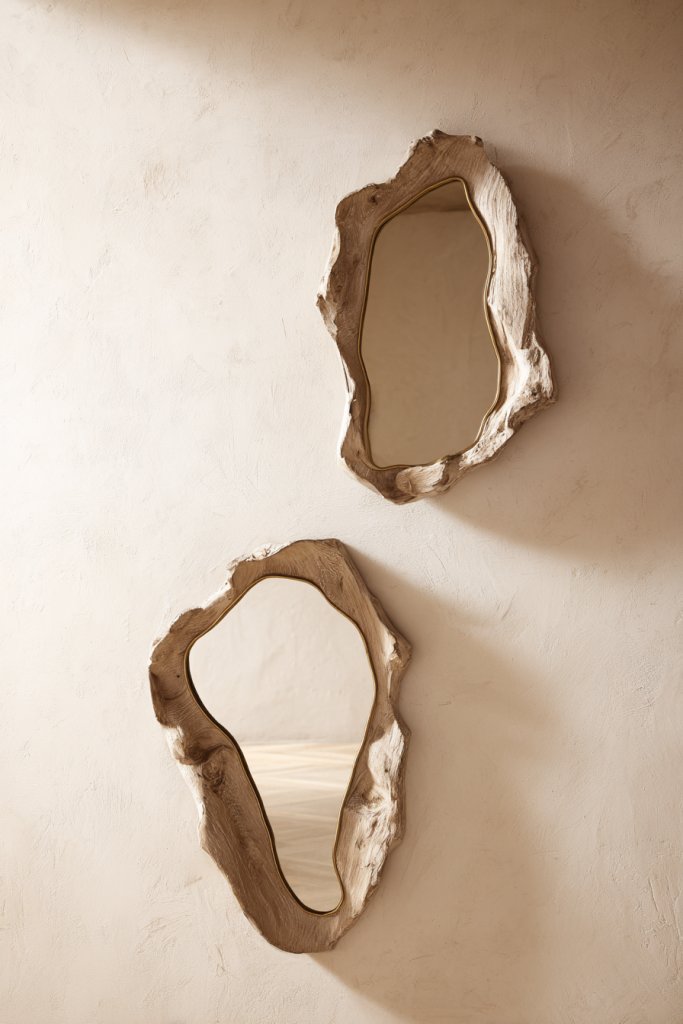
Ever feel like your space is missing that wow factor or a touch of character? Sometimes, perfectly symmetrical decor just doesn’t cut it in a Wabi-Sabi-inspired interior. You want something that feels natural, imperfect, and uniquely beautiful—something that tells a story. Mirrors with organic, irregular shapes can add that subtle yet striking element that elevates your room’s personality.
Imagine a mirror with an uneven, hand-formed frame that looks like it was shaped by nature itself. Its irregular contours reflect soft, diffuse light, creating gentle shadows that add depth and texture to your walls. The mirror’s imperfect shape draws the eye and invites closer inspection, making even a simple wall feel alive and interesting. The rustic, distressed surface enhances its organic charm, making it a focal point without overwhelming the space.
You can choose mirrors with distressed finishes for a vintage vibe or sleek, uneven edges for a modern, rustic fusion. They work well in small nooks or as statement pieces above a plain console or shelf. For seasonal changes, pair these mirrors with textured fabrics or layered textiles to keep the look fresh and inviting. They adapt easily to different styles—from farmhouse to minimalistic—adding a touch of unexpected beauty.
Start by selecting mirrors with irregular, handcrafted frames from local artisans or vintage shops. Measure your wall space and pick a size that complements the room’s proportions. Mount the mirror at eye level for maximum impact, ensuring it’s securely anchored. Consider pairing it with simple, textured wall finishes like lime wash or plaster to further enhance the rustic, organic feel. Avoid overly ornate frames—simplicity in irregularity is key here. Regular cleaning with a soft cloth preserves the natural surface’s character.
Personalize your mirror by adding subtle accents around it, like woven textiles or reclaimed wood frames, to emphasize its organic vibe. You could also incorporate small sculptural objects on nearby shelves for a curated, earthy look. Experiment with different finishes—matte, distressed, or lightly polished—to match your overall aesthetic. Don’t shy away from mixing sizes and shapes for a dynamic, gallery-like arrangement.
These mirrors remind us that beauty doesn’t have to be perfect. They add warmth, depth, and a touch of nature to any space, making your home feel more authentic and inviting. Once you embrace irregular shapes, you’ll see how they effortlessly elevate your interior’s harmony. Ready to experiment with some organic charm? Your space will thank you for the natural, imperfect beauty.
13. Use Simple, Unadorned Plant Stands with Natural Materials (Alternatives to restricted items)
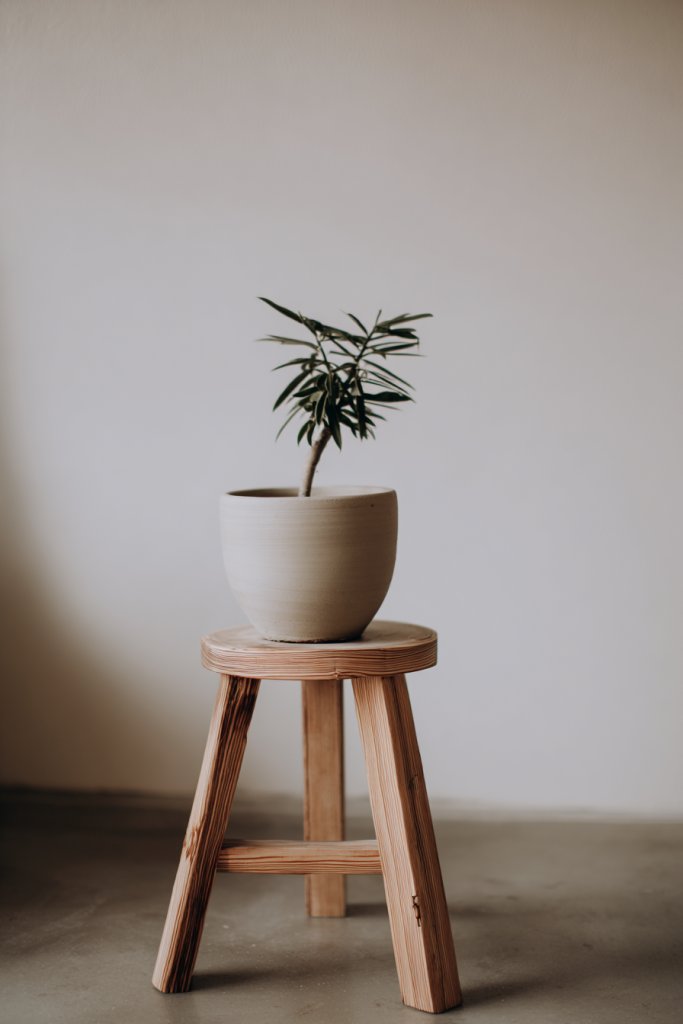
Do you find yourself overwhelmed by the endless choices of decorative plants and their containers? Keeping plants alive is one thing, but showcasing them stylishly without clutter can be tricky—especially if you want to keep things minimal and natural. Using simple, unadorned plant stands made from raw materials offers a perfect solution to showcase greenery without overpowering your space.
Picture a raw wooden tripod stand with visible grain and imperfections, holding a lush, unpretentious plant. Or imagine a sleek, matte clay pot on a simple, unpolished pedestal that complements the plant’s organic form. These stands focus attention on the plant’s natural beauty, while their understated design blends seamlessly into a Wabi-Sabi environment. The tactile textures of wood and clay add warmth and authenticity, creating a tranquil, earthy vibe.
Choose materials like weathered wood, unglazed clay, or even raw jute for a more rustic or industrial feel. Use different heights and shapes to create visual interest in corners or along shelves. During different seasons, swap out plants or change their placements to refresh the look. These stands are versatile enough to suit small balcony gardens or cozy indoor corners, adapting easily to your space’s needs.
Start by selecting sturdy, simple stands that highlight natural materials—think unfinished wood or unglazed ceramic. Position them on clean surfaces or directly on the floor for a more grounded appearance. Use lightweight, easy-care plants like succulents or grasses, which look great in unadorned containers. Secure the stands properly to prevent tipping, especially if you have pets or kids. Regularly dust and care for the materials to maintain their raw beauty.
Add subtle details like woven jute wraps around the base or hand-carved patterns on clay pots for a personalized touch. Incorporate textured fabrics or linens nearby to complement the materials. You can also layer different heights for a more dynamic display, or group several stands for a mini indoor garden. Mix and match natural textures to create a cohesive, relaxed aesthetic that feels handcrafted.
These simple stands prove that less is more. They let the beauty of your plants and natural materials shine through, adding calm and authenticity to your home. Embracing minimalism with raw elements creates a peaceful retreat from clutter. Ready to reduce the fuss and showcase your greenery in style? Your home will radiate effortless natural charm.
14. Incorporate Handmade Textured Rugs in Neutral Hues
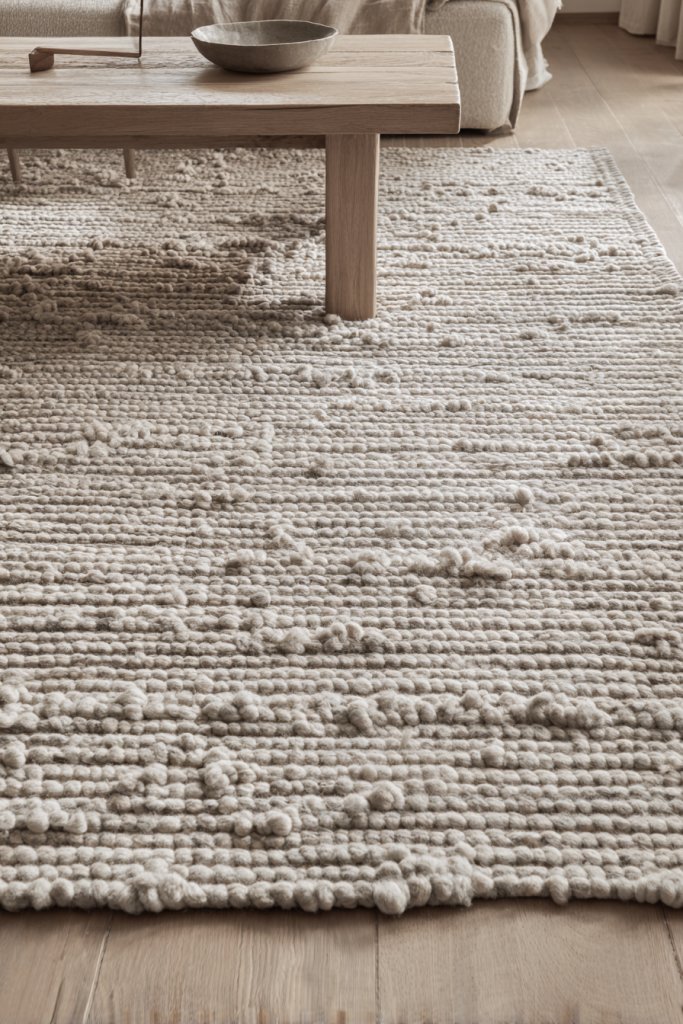
Ever walk into a room that feels cold or sterile and wish you could add warmth without cluttering the space? Textured rugs in neutral tones are a perfect way to bring tactile softness and visual depth into any room. They anchor the space with subtle complexity and create a cozy, inviting atmosphere—without being overpowering.
Imagine a handwoven rug with uneven edges, made from natural fibers like jute or wool. Its surface has a tactile variation—knotted loops, fringed edges, or irregular patterns—that invites you to step barefoot and feel the craftsmanship. The muted, earthy hues—beige, taupe, or soft gray—blend effortlessly with the surrounding decor, enhancing the natural, imperfect aesthetic. The textured surface absorbs light and shadows, adding depth and warmth.
Choose rugs with simple patterns or no patterns at all for a truly understated look. Layer them over other textiles like linen or raw cotton throws for depth. During seasonal transitions, swap out rugs to reflect changing textures or colors—think warm reds or deep browns for fall, light neutrals for spring. They work well in living rooms, bedrooms, or even entryways, adapting to any space’s needs.
Select rugs made from natural, durable fibers that resist wear and fading. Measure your room carefully to choose the right size—aim for a rug that extends beyond furniture edges to define the space. Place them on plain, hard floors for maximum contrast or over existing textiles for layering. Keep them clean by vacuuming regularly and avoiding harsh chemicals—maintenance is minimal but essential for longevity. For added authenticity, choose handwoven or artisanal pieces with visible craftsmanship.
Personalize your rug by pairing it with textured cushions or throws that echo its natural fibers. Add decorative baskets or wooden accents nearby to enhance the earthy vibe. Play with layered textures—think a soft cream throw blanket with chunky knit texture—around the rug for a cozy corner. The key is to keep everything simple, letting the natural beauty of the rug shine.
A textured rug in neutral hues transforms your space into a sanctuary of calm and understated elegance. It reminds us that beauty can be found in the imperfect and the handmade. When you embrace natural fibers and artisanal craftsmanship, your home gains a soulful, authentic feel. Ready to add tactile warmth? Your space will become a haven of subtle sophistication.
15. Curate a Collection of Weathered, Vintage Finds for Character

Feeling like your home is missing a story or sense of history? Sometimes, new decor can feel a little staged or soulless. Curating vintage and weathered items adds layers of authenticity and personality—each piece telling its own story. Collecting these treasures turns your home into a curated gallery of character and charm.
Visualize a shelf lined with old glass jars, tarnished metal tools, and aged books with worn spines. Their surfaces are scratched and faded, yet they radiate a quiet beauty that new objects can’t replicate. These items, placed thoughtfully among minimalist furniture, create a balanced contrast of age and freshness. The weathered textures, combined with soft lighting, evoke nostalgia and warmth, making the space feel lived-in and loved.
Mix vintage pieces with modern minimalism for an eclectic, layered look. Display aged ceramics or metal trinkets on open shelves or atop simple tables. During different seasons, swap out or add new vintage finds to keep the collection fresh and inspiring. They suit various rooms—from kitchens to living spaces—adding character and depth without overwhelming.
Begin by scouting antique markets, thrift shops, or online vintage stores for authentic pieces. Focus on items with natural patina—worn edges, faded paint, or rust—adding to their charm. Arrange items in groups or clusters to create visual interest, avoiding clutter. Preserve their aged look by cleaning gently and avoiding over-polishing. Integrate them into your existing decor by pairing with neutral textiles or simple furniture to highlight their uniqueness.
Create a sense of story by pairing vintage objects with handwritten labels or small notes. Incorporate personal mementos or family heirlooms to deepen the connection. Display items at different heights using simple stands or stacking for visual variety. Mix materials—wood, metal, glass—to keep the collection dynamic and rich.
Vintage finds add a soulful, imperfect charm that breathes life into any space. They serve as conversation starters and a reminder of history’s beauty. Curating a collection of weathered pieces makes your home uniquely yours. Embrace the imperfect and let your space tell its own story.
16. Highlight Natural Light with Simple, Unobtrusive Window Treatments

Ever feel like your rooms are shadowed or too dark, even during the day? Maximizing natural light is a key element in creating a serene Wabi-Sabi aesthetic. Heavy drapes or busy window treatments can block the sun and clutter your view. Sometimes, simplicity is the best solution to allow light to pour in and breathe life into your space.
Imagine sheer linen curtains gently diffusing sunlight, creating soft, warm shadows across textured walls. Or picture a window left bare, showcasing the outside world’s organic shapes—trees, clouds, or weathered stone. The natural light highlights the subtle imperfections of your decor—rough plaster, worn wood, or textured fabrics—making everything feel more authentic and alive. The play of light and shadow adds depth and tranquility, transforming your room into a peaceful retreat.
Use lightweight, natural fabrics like linen or raw cotton in neutral tones for a timeless look. For seasonal adjustments, opt for heavier textiles in winter or switch to no treatments in summer to maximize light. Install simple rods or hooks to allow easy removal or drawing back of curtains. In spaces with large windows, consider minimal framing or even no curtains at all for a pure, unobstructed view.
Choose sheer, unpatterned fabrics in natural hues that complement your overall decor. Mount rods close to the ceiling for an illusion of height and to let the fabric fall naturally. Keep window hardware minimal—think unobtrusive brackets or hidden tracks—to preserve the clean, simple aesthetic. Regularly wash curtains to maintain clarity and light diffusion. For a more permanent solution, consider frosted or textured glass options that diffuse light without fabric.
Personalize by adding subtle tiebacks made from natural fibers or simple leather straps. Layer window treatments with textured blinds or shades that can be easily opened or closed. Use light-colored or semi-translucent fabrics to bounce light around the room, enhancing the organic feel. Keep the window area uncluttered—let the outside scenery be part of your decor.
Natural light makes your space feel expansive, calm, and connected to the outdoors. It’s a simple, effective way to elevate the Wabi-Sabi aesthetic without adding clutter. When you embrace unobtrusive window treatments, you invite warmth and serenity into your home. Ready to let the sunshine in and highlight the beauty of imperfections?
17. Integrate Organic-Shaped Clay or Stone Decor Pieces

Looking for small touches that bring a sense of earthiness and authenticity to your home? Organic-shaped clay or stone decor pieces can subtly evoke the natural world and add tactile interest. They serve as understated accents that complement the imperfect beauty of Wabi-Sabi without shouting for attention. Sometimes, the smallest details make the biggest difference.
Visualize a rough-edged clay bowl with uneven glazes resting on a raw wooden shelf or a weathered stone sculpture placed on a simple side table. Their irregular shapes and textures invite touch and curiosity, grounding your decor in natural materials. These pieces reflect the imperfect, raw beauty of nature—each one slightly different, each one telling its own story. The tactile quality adds warmth and depth, creating a calm, earthy atmosphere.
Choose pieces with raw, unpolished surfaces or subtly glazed finishes for a rustic, modern look. Mix different sizes and shapes for a curated display—think small bowls, sculptures, or abstract forms. During different seasons, rotate these accents to keep the aesthetic fresh. They fit well on open shelves, coffee tables, or window sills, blending seamlessly into a natural, understated decor scheme.
Start by sourcing handmade clay or stone objects from artisans or craft markets. Focus on pieces with organic, flowing shapes and natural textures—avoid overly refined or symmetrical items. Arrange them thoughtfully, balancing sizes and forms for visual harmony. Use gentle cleaning methods—avoid harsh chemicals—to preserve their natural patina. Incorporate lighting that emphasizes their textures, like warm spotlights or natural sunlight.
Personalize with engraved or carved details or by pairing with textured fabrics or greenery in unadorned containers. Group similar items together to create mini vignettes or spread them out for a more organic feel. Combine with natural textiles like linen or wool to enhance the tactile experience. These accents become part of your home’s story, reflecting your appreciation for imperfections.
Adding organic-shaped clay or stone pieces grounds your space in nature and authenticity. They remind us that beauty exists in the raw and unrefined. Incorporating these simple accents transforms your home into a sanctuary of calm and natural elegance. Ready to embrace the imperfect beauty of earth-toned materials?
18. Incorporate Natural Elements like Driftwood or Twigs in Decor
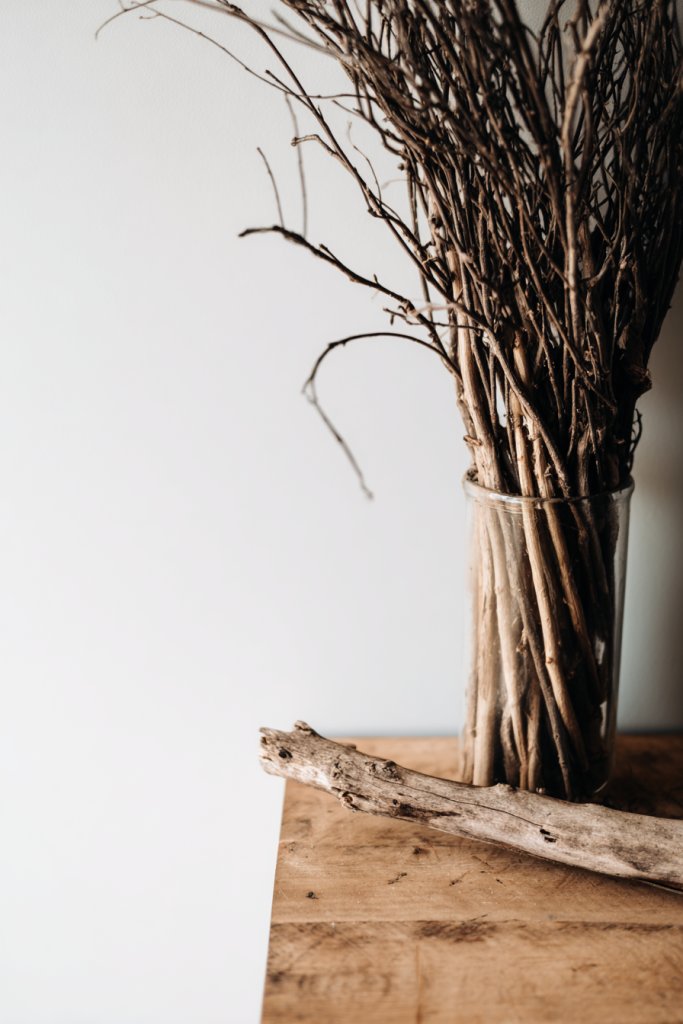
Ever felt like your home is missing that earthy, grounded vibe that makes it feel alive? Natural elements like driftwood and twigs can instantly bring a sense of the outdoors inside without turning your space into a botanical jungle. They add texture, warmth, and a quiet reminder of nature’s imperfect beauty. If you crave a space that feels organic and effortless, incorporating these pieces might be your new secret.
Picture a weathered piece of driftwood placed horizontally on a shelf, with rough bark and knobby knots catching the light. A bundle of twigs, loosely tied with twine, stands upright in a handmade ceramic jar. These natural sculptures complement textured fabrics and rough-hewn furniture, creating a tactile, layered environment. The scent of wood and earth subtly fills the air, immersing you in a calm, outdoor-inspired atmosphere.
Use driftwood as a centerpiece on a dining table or as part of a wall-mounted sculpture. Twigs can be woven into wreaths or arranged in minimalist vases, avoiding traditional floral displays. For a more modern twist, combine these natural elements with industrial metals or concrete for a contrasting yet harmonious look. Seasonal adjustments include adding dried leaves or moss for autumn, or keeping it stark and simple for winter.
Start by sourcing authentic driftwood from beaches or riverbanks, ensuring they’re thoroughly cleaned and dried. Collect twigs that have interesting shapes and textures—avoid overly uniform or processed pieces. Use natural twine, leather strips, or wire to secure or arrange them. Display them on open shelves, mantelpieces, or as standalone sculptures on the floor. Combine with other organic textures like stone or raw ceramics to enhance the earthy feel. Regularly dust and inspect for pests or mold, especially if sourced outdoors.
Create your own arrangements by combining different sizes and shapes of driftwood and twigs. Add personal touches like carved initials or painted accents for a custom look. Incorporate them into existing decor—such as wrapping a twig bundle with a favorite fabric or attaching small charms. These natural elements age beautifully and develop character over time, making your space feel more lived-in and authentic.
Bringing the outdoors inside doesn’t mean turning your home into a forest. It’s about subtle hints—textures and shapes that evoke calm and connection. Personalize your arrangements to reflect your journey or memories, and enjoy the organic imperfections. These pieces remind us that beauty often lies in natural unpredictability.
19. Use Hand-Thrown Pottery for Functional and Decorative Items
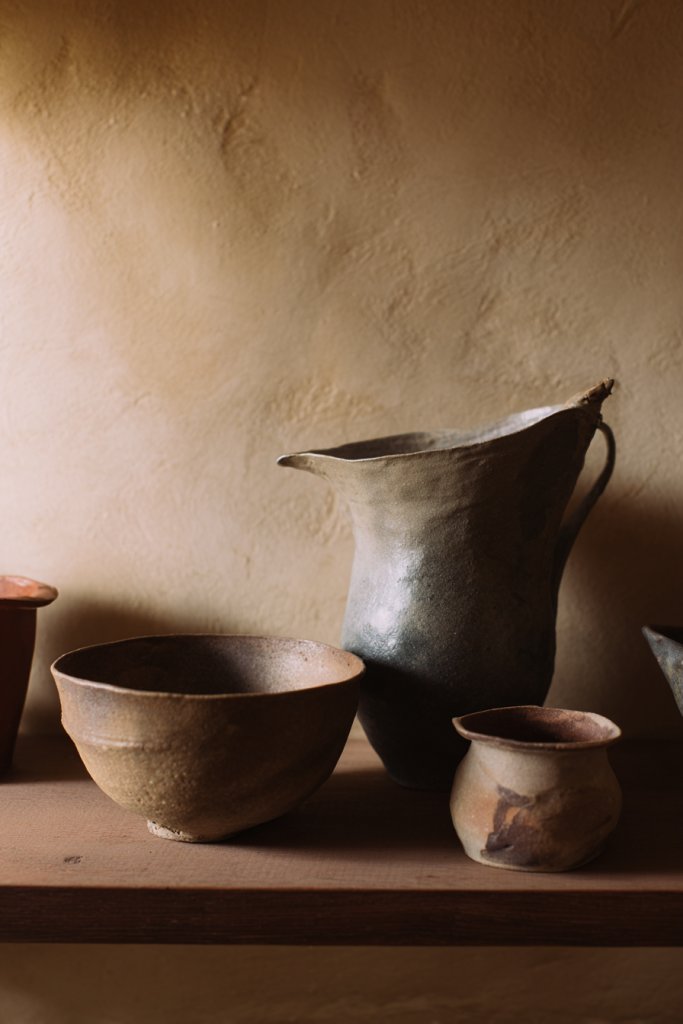
Tired of mass-produced, cookie-cutter decor that feels soulless? Hand-thrown pottery offers a warm, authentic touch that elevates everyday objects into art. Each piece tells a story of craftsmanship and imperfection, perfectly aligning with Wabi-Sabi ideals. Plus, using handmade ceramics adds a layer of tactile pleasure and uniqueness to your home.
Visualize a collection of mismatched bowls with uneven rims, glazed in muted, earthy tones. A mug with a slight asymmetry rests beside a textured, matte vase. These imperfect shapes and subtle variations showcase the beauty of craftsmanship. The rough, matte surfaces contrast with glossy accents in some pieces, creating visual interest and depth. When arranged on open shelving, they invite touch and curiosity.
Use ceramics for serving, display, or as standalone art pieces. Mix different sizes and forms—think small planters, large serving bowls, and petite cups—to create a curated, eclectic collection. Incorporate seasonal motifs like textured snowflakes or rustic leaves for holiday decor. For minimalist spaces, select a few key pieces with bold textures or subtle glazes to keep things simple yet impactful.
Source handmade pottery from local artisans, craft fairs, or online marketplaces. Focus on pieces with visible imperfections—like uneven textures or color variations—that celebrate their handmade origins. Display them on open shelves, countertop corners, or as centerpiece accents on dining tables. Use soft, natural lighting to highlight their textures and colors. Avoid overloading surfaces—let each piece breathe and stand out.
Create a personal collection by choosing pieces that resonate with your style or memories. Mix in textured glazes or matte finishes for added depth. Incorporate your favorite colors or motifs, or even commission custom pieces for a truly personal touch. Use these ceramics as functional items or decorative accents, and consider displaying them with other organic materials like wood or linen.
Every handmade piece carries a story and adds soul to your home. They remind us that beauty can be imperfect and still perfect. Embrace the variations and let them inspire a home that feels authentic and cozy. Your space will radiate warmth and craftsmanship, setting a tone of mindful living.
20. Choose Low-Profile, Simplistic Furniture with Visible Joints

Ever feel overwhelmed by bulky furniture that dominates your space? Simplistic, low-profile furniture offers a breath of fresh air, making rooms feel open and calm. When joints and craftsmanship are visible, it adds an artisanal touch that aligns well with Wabi-Sabi ideals. Plus, it encourages a less-is-more mindset and highlights natural materials.
Picture a sleek, low sofa with exposed wooden joints, showcasing craftsmanship. The frame is made of weathered timber with visible grains and rough edges. A simple coffee table with visible dowel joints complements the setup. The overall aesthetic is understated but rich in texture, emphasizing natural imperfections and honest construction. Soft, diffuse lighting accentuates the raw beauty of the materials.
Opt for furniture with natural finishes, like unfinished or lightly stained wood. Minimalist designs work well in small spaces, while larger rooms can accommodate longer, sectional pieces. Exposed joinery and natural joints add character, making each piece unique. For a layered look, pair with textured textiles and simple accessories, always keeping clutter minimal.
Prioritize quality craftsmanship—look for furniture with visible joinery, such as mortise and tenon or dovetail joints. Choose natural materials like reclaimed wood or rough-hewn timber. Assemble or purchase pieces that celebrate their construction, avoiding overly polished surfaces. Keep the design simple—avoid ornate details—so the joints and materials stand out. Regular maintenance involves gentle cleaning and occasional oiling or sealing to preserve the natural finish.
Add personal touches by choosing pieces with distinctive joints or handcrafted details. Mix different wood tones or textures for visual interest. You can also customize by adding handcrafted cushions or throws that complement the natural aesthetic. DIY enthusiasts might consider building or modifying furniture to showcase exposed joints and natural flaws.
Seeing the craftsmanship in your furniture boosts appreciation for imperfection and artisanal quality. It encourages a home that celebrates authenticity and skill. Choosing simple, honest furniture creates a space that’s calming, functional, and full of character—perfect for embracing Wabi-Sabi living.
21. Incorporate Subtle, Textured Wall Treatments like Plaster or Lime Wash
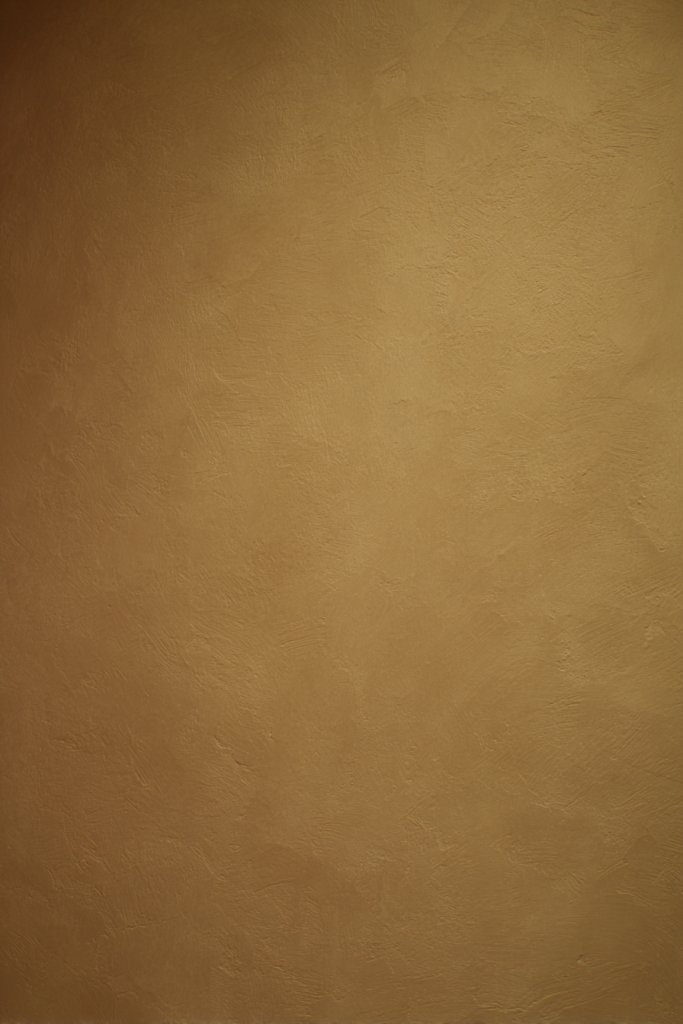
Tired of flat, boring walls that don’t add character? Textured wall treatments like plaster or lime wash can transform plain surfaces into tactile, organic backdrops. They introduce depth and subtle variation, echoing nature’s imperfections. If you want your walls to whisper quiet elegance, these finishes are the way to go.
Imagine a wall coated in a matte lime wash, with irregularities and slight color variations that catch the light differently throughout the day. The texture is subtle but noticeable—like the surface of a soft stone. In another corner, a textured plaster wall with a slightly rough, uneven finish adds visual interest. These surfaces create a warm, inviting atmosphere that feels rooted in tradition.
Apply lime wash or textured plaster in earthy tones—warm taupe, soft gray, or muted beige—suited for Wabi-Sabi interiors. These finishes work well in combination with natural wood or unpolished stone. For a more modern look, keep the textures subtle and monochromatic. Textured walls are versatile for both small accent walls or entire rooms, depending on your preference.
Start by preparing the wall surface—clean, dry, and free of loose debris. Use natural plaster or lime wash mixes, following manufacturer instructions. Apply with trowels or brushes, intentionally leaving some unevenness for authenticity. Multiple thin coats build depth without looking overly uniform. Finish with a natural sealant or breathable coating if desired. Regular maintenance involves gentle cleaning; avoid harsh chemicals that could damage the texture.
Customize wall textures by varying application techniques—scraping, sponging, or layering different shades. Incorporate subtle color shifts to mimic natural stone or earth tones. Add handcrafted wall-mounted elements like sculptural ceramics or woven textiles—avoiding paintings—to complement the textured surface. This layered approach enhances the tactile and visual experience.
Textured walls deepen the sense of authenticity and craftsmanship in your home. They serve as a canvas for understated elegance that ages beautifully. Embrace the imperfection and let your walls tell a story of natural beauty and craftsmanship, elevating your entire space.
22. Display Worn, Frayed, or Naturally Faded Textiles as Art
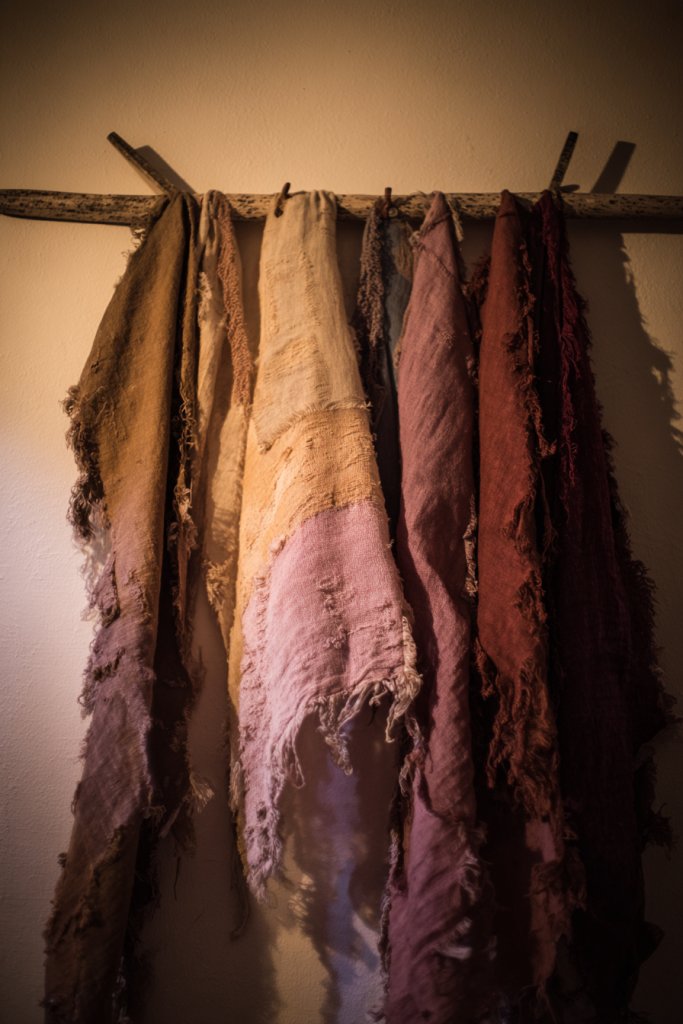
Looking for a way to add warmth and character without buying new, perfect decor? Worn, frayed, or faded textiles carry a quiet beauty that speaks of history and imperfection. They turn everyday fabrics into art pieces, embodying the Wabi-Sabi philosophy. If you want your home to feel cozy and authentic, embracing these textures might be your best move.
Envision a vintage linen tablecloth with frayed edges, draped casually over a sideboard. An old muslin curtain, with patches and fading, hangs loosely on a window. These textiles, with their visible wear and tear, create a layered, lived-in look. They soften the space with their subtle imperfections and tell stories of years gone by. The light catches the frayed edges, highlighting their aged beauty.
Use these textiles as wall hangings, table runners, or throw blankets for a relaxed vibe. Combine different faded fabrics in neutral hues for a monochromatic, cohesive look. For a minimalist aesthetic, display a single piece with interesting fraying or fading. Seasonal swaps, like heavier fabrics in winter or lighter, more delicate ones in summer, keep the look fresh and appropriate.
Source vintage or intentionally distressed textiles from thrift stores, flea markets, or DIY projects. Avoid overly perfect or new fabrics—look for those with visible signs of age. Use simple rods or clips to hang textiles on walls or windows. Incorporate them into your decor by layering with rough textiles like burlap or linen. Regularly clean and gently mend any tears to preserve their character.
Personalize by adding subtle embroidery, embroidery, or stitching to enhance the worn look. Mix in fabrics with different textures and shades for depth. Use frayed textiles as backgrounds for small displays of handcrafted objects—again, avoiding polished or glossy finishes. These textiles add an emotional, nostalgic element to your decor.
Worn textiles remind us that beauty is often found in age and imperfection. They evoke a sense of history and authenticity that can’t be replicated artificially. Embrace their flaws, and let them add a soulful layer to your home that feels warm, inviting, and genuinely yours.
23. Create a Serene Nook with a Low-Profile Floor Seating Area

Ever wish for a quiet corner to meditate, read, or just escape the chaos? A low-profile floor seating area offers a peaceful retreat right in your home. It’s simple, unpretentious, and deeply calming—perfect for embracing Wabi-Sabi’s love for simplicity. Creating this nook can turn a corner into a sanctuary for mindfulness.
Imagine a cozy space with a large, woven cushion or futon on a natural fiber rug. Soft, textured throws are casually draped nearby, inviting you to sit. The surrounding walls are unadorned, with natural materials like wood and linen dominating. Gentle ambient lighting, maybe from a hidden lamp or candle, bathes the space in warmth. It’s a space that feels organic, calm, and effortlessly inviting.
Adjust the size and number of cushions based on your space and needs. Use neutral or earthy tones to keep the ambiance serene. Incorporate personal touches like a handcrafted blanket or a textured mat. For seasonal variations, swap out cushions or add layers of wool or cotton for comfort. This space can be tucked into a corner, by a window, or even outdoors for a natural retreat.
Choose low, simple seating like cushions, futons, or bean bags made from natural fibers. Select textured, organic fabrics such as linen, cotton, or wool for covers. Lay the area on a natural fiber rug—think jute or hemp—for grounding. Add a few layered throws or cushions for comfort and visual interest. Keep the space uncluttered, focusing on tactile textures and natural materials.
Personalize by selecting cushions with subtle embroidery or fringe details. Incorporate meaningful objects like a small handcrafted sculpture or a piece of driftwood nearby. Use soft lighting like candles or paper lanterns to create a meditative glow. Keep accessories minimal to preserve the calm, unhurried vibe.
Turning a corner into a peaceful nook encourages daily mindfulness and calm. It’s a personal retreat that grows more meaningful over time. The simplicity and natural materials foster a sense of authenticity and well-being—perfect for fostering a serene home environment.
24. Incorporate Minimal, Unassuming Decorative Objects with Personal Touches
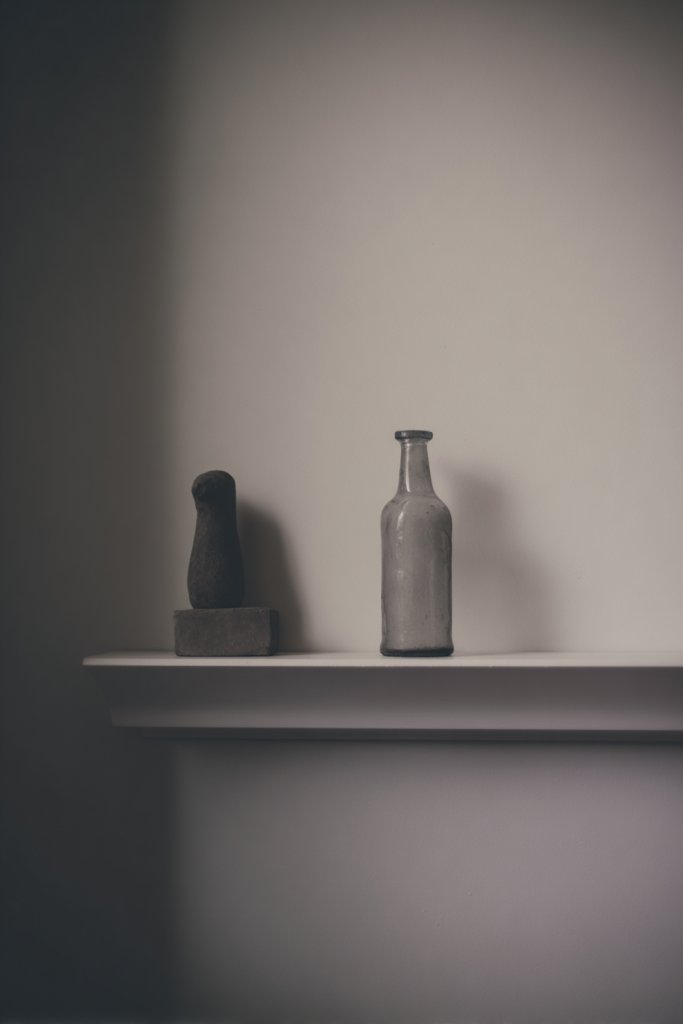
Do you ever feel overwhelmed by cluttered decor that distracts from your home’s true character? Minimal, unassuming objects allow your space to breathe and breathe personality into your environment. When chosen thoughtfully, they can evoke calm and authenticity, aligning perfectly with Wabi-Sabi ideals. If simplicity is your goal, this approach is a game-changer.
Visualize a simple wooden bowl with a rough finish, placed on a bare shelf. Nearby, a handcrafted ceramic dish with uneven edges adds subtle interest. These understated objects, with their natural textures and imperfections, create a quiet elegance. The arrangement is sparse but meaningful, inviting appreciation of each piece’s craftsmanship and history. Soft, indirect light highlights their textures and simplicity.
Choose objects that tell a story—handmade, vintage, or heirloom pieces—avoiding mass-produced items. Keep surfaces uncluttered, with only a few well-chosen objects to create a sense of intentionality. Mix materials like wood, ceramic, and stone for variety without overwhelming. Seasonal or mood-based changes can be made by swapping or repositioning objects, always maintaining restraint.
Start by decluttering and identifying meaningful objects—things with texture, history, or personal significance. Display them on open shelves, in nooks, or on simple trays. Avoid glossy or overly ornate pieces; instead, select items that show their age or craftsmanship. Maintain the arrangement with regular dusting and minimal rearrangement to keep the aesthetic fresh yet understated.
Add personal touches by incorporating objects that reflect your journey—like a handmade token or a vintage find. Use natural materials and textures to keep the look cohesive. Incorporate subtle variations in shape and size for visual interest, and layer objects thoughtfully for depth. This curated simplicity allows your personality to shine through.
Minimal, authentic decor reminds us that less is often more, and imperfection adds charm. It encourages mindful living and appreciation for craftsmanship. With each carefully selected object, your space becomes a reflection of your personality and values—calm, authentic, and uniquely yours.
Conclusion
From rustic decor accents to embracing natural materials, these Wabi-Sabi interior ideas showcase the diverse ways to infuse authenticity and tranquility into your home. Don’t hesitate to experiment with these concepts and create a space that truly reflects your love for natural beauty and imperfect charm. Embrace the journey toward a more peaceful, authentic living environment—your perfect Wabi-Sabi sanctuary awaits!